
Figure 1. Frederick Augustus Le Mesurier as a Major in South Africa in 1880.
(Photograph courtesy of Alasdair Goold-Verschoyle)
Colonel
FREDERICK
AUGUSTUS LE MESURIER, CB, LL.B.
Royal Engineers
by
Lieutenant
Colonel (Retired) Edward De Santis, M.S.C.E., P.E., MinstRE
U.S.
Army Corps of Engineers
(June 2024)

Figure 1. Frederick Augustus Le Mesurier as a Major
in South Africa in 1880.
(Photograph courtesy of Alasdair
Goold-Verschoyle)
1. INTRODUCTION
The Le Mesurier family is an interesting one. While searching the family trees on Ancestry.com for Frederick Augustus Le Mesurier I quickly found information about his father, four brothers, three sons, 10 nephews and 11 great nephews. Of these 30 individuals, 13 served in the naval and military forces of the British Empire from the Victorian era through World War 2. While this research work will concentrate primarily on Frederick Augustus Le Mesurier, information also will be presented to cover the lives and military service of other family members, albeit not in quite as much detail as with the main character of the story. As the research progressed, the lives of some of the other family members were found to be extremely interesting.
The reference section at the end of this narrative provides a comprehensive list of the sources used to produce the Le Mesurier story. Every effort has been made to accurately describe the lives and military service of the men.
Le Mesurier, LeMesurier, Lemesurier, Le Masurier and Le Messurier are variant spellings of a family name originating in the Channel Islands.
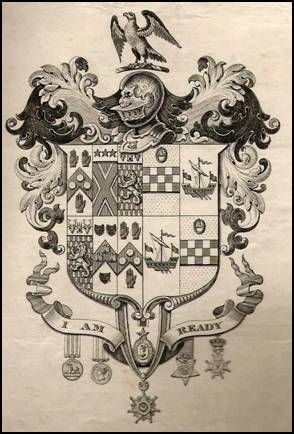
Figure 2. The Le Mesurier Family Crest.
(Image
courtesy of Wikipedia)
2. EARLY LIFE AND FAMILY INFORMATION
Parents and Siblings
Frederick Augustus Le Mesurier was born on the 17th of March 1839 in Newbury, Berkshire. He was the youngest child of Commander Frederick Henry Le Mesurier, Royal Navy (1796-1865), and Jane Catharine Le Mesurier (1800-1882), née Maunsell, the daughter of T.C. Maunsell of Thorpe Malsor, Northamptonshire.1 Frederick Henry and Jane had five other children prior to Frederick’s birth; Catharine (1830-1841), Cecil Brooke (1831-1913), George Frederick (1833-1904), Thomas Maunsell (1834-1888) and Andrew Alfred (1837-1894).2
Education
As a young boy Frederick Augustus Le Mesurier attended Rodwell College in Wyke Regis, Weymouth,3 the Royal Naval School at New Cross in London and the Royal Military Academy at Woolwich.4
|
Figure 3. A Photograph Thought to be of Jane Catharine Le Mesurier. (Photograph courtesy of various family trees found on Ancestry.com) There is some contention regarding the validity of this photograph. Some genealogical researchers of the Le Mesurier family do not agree that this is her photograph. |
3. PHYSICAL DESCRIPTION AND CHARACTER
Unfortunately a detailed service record could not be found for Frederick Augustus Le Mesurier. This record, if it exists, would provide a more detailed physical description of the man.
In his obituary he was described as tall, slight of build and of distinguished appearance with muscles of steel and nerve to match. His intellect was keen and his character strong. He was described as being as extremely democratic in his opinions as he was fastidious in his tastes. As an example, he always washed copper coins that came into his possession before he would use them. He held strong and unusual views about church matters and was quite uncompromising. He also took great interest in an Oxford yard for unemployed men, which he mainly managed after he retired from the Army.
4. COMMISSIONING AND TRAINING
After successfully completing his studies at the Royal Military Academy, Gentleman Cadet Frederick Augustus Le Mesurier was commissioned a Lieutenant in the Royal Engineers on the 1st of October 1857.5 Following his commissioning he was posted for training to the School of Military Engineering (S.M.E.) in Chatham, Kent. At the S.M.E. he would have attended courses in field fortifications, construction, technical surveying, military topography, signalling, chemistry and military law to prepare him for command and staff postings at various levels within the Corps of Royal Engineers.
5. ASSIGNMENTS AND CAMPAIGN SERVICE
Trinidad (1861-1863)
Following his training at Chatham Lieutenant Le Mesurier was posted to Trinidad in 1861 where he assumed duties as the Superintendent of Public Works. He remained in Trinidad until 1863 when he was assigned to duties in Ireland where he married Louisa Anne Brown (see Section 9).6
Ireland (1863-1869)
On the 11th of July 1867 Lieutenant Le Mesurier was promoted to the Regimental Rank of 2nd Captain, vice 2nd Captain Morgan Croft Molesworth who had recently died, thus leaving a vacancy in that rank of the Royal Engineers.7 His rank would subsequently be changed to that of First Lieutenant when the rank of 2nd Captain was eliminated in the British Army. On the 1st of May 1869 Le Mesurier was posted to the School of Military Engineering at Chatham as an Assistant Instructor in Army Signalling.
Chatham (1869-1875)
While serving at Chatham, the 1871 Census of England shows the Le Mesurier family living in Gillingham, Kent, a town located immediately adjacent to Brompton Barracks and the School of Military Engineering. The Le Mesurier household in 1871 is shown in the census below.
1871 Census of England
Name and Surname |
Relation |
Marital Status |
Age |
Profession or Occupation |
Birthplace |
Frederick Augustus Le Mesurier |
Head |
Married |
32 |
Captain |
Newbury, Berkshire |
Louisa Le Mesurier
|
Wife |
Married |
35 |
|
Mayo, |
Eugene Le Mesurier |
Son |
|
4 |
|
Canterbury, |
Sydney Le Mesurier |
Son |
|
1 |
|
New Brompton, |
Sarah H. Cooper |
Servant |
|
18 |
Nursemaid |
Lowestoft, |
Emma Derrick |
Servant |
|
15 |
Housemaid |
Chatham, |
On the 5th of
July 1872 Le Mesurier was promoted to the Regimental Rank of
Captain.8
Although this was the announced date of his promotion, due to the
changes in the rank structure that had taken place in the British
Army during the few years prior to this, his date of rank as a
Captain was backdated to the 11th of July 1867, owing to
the elimination of the rank of 2nd Captain. This
modification of his date of rank resulted in a significant advantage
to him, as he gained five years of seniority. Instead of being a
newly promoted Captain with 15 years of service, he was now a Captain
with five years in grade.
Bermuda (1875-1876)
Captain Le Mesurier left Chatham in 1875 and was assigned to command the 26th Company, Royal Engineers which was then stationed in Bermuda.9 He commanded the company for less than a year when he was appointed to be the Inspector of Army Signalling and was ordered home to Aldershot, Hampshire.10 This was rather unusual, as officers normally spent more than one year in command of a company. No information has been uncovered to indicate that Captain Le Mesurier requested this posting home for compassionate or any other reason. Why he was chosen to serve in a position dealing with Army Signalling also is an interesting question.
Aldershot (1876-1880)
In addition to his position as Inspector of Army Signalling, upon his arrival at Aldershot he also was appointed Deputy Assistant Quartermaster Generally for Signalling.11 This was the third posting that he had involved with signalling duties but no information has been uncovered to indicate why he was chosen for this specialty within the Corps of Royal Engineers. Obviously it must have been noted early on in his career that he had some special skills in this area.
On the 1st of October 1877 while at Aldershot, Captain Le Mesurier was promoted to the Regimental Rank of Major. In 1880 he departed his post at Aldershot and sailed for South Africa where the Boers were causing some difficulties. Major Le Mesurier was headed directly into the conflict which would come to be known as the First Boer War. He was destined to take part in the Transvaal Campaign of 1880 to 1881.
South Africa (1880-1882)
Upon arriving in South Africa Major Le Mesurier was ordered to the town of Pretoria in the Transvaal where he assumed command of the 2nd Field Company, Royal Engineers. Serving under Major Le Mesurier as company officers were Lieutenants R.P. Littledale, R.E.12 and C.E. Commeline, R.E.13 As the senior engineer officer in the town, Le Mesurier also assumed the duties of Commander Royal Engineer (C.R.E.) for Pretoria.14
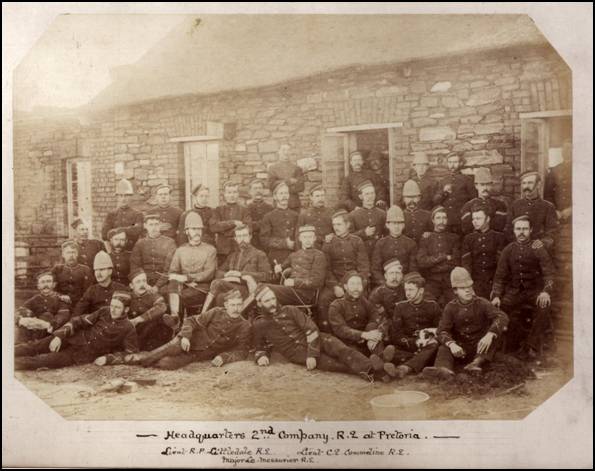
Figure 4. Headquarters of the 2nd
Company, Royal Engineers at Pretoria, South Africa.
(Photograph
courtesy of Fred Larimore)
NOTE: The officers in the photograph above are seated in chairs in the center of the row. They are, from left to right, Lieutenant Littledale (with helmet), Major Le Mesurier (bareheaded) and Lieutenant Commeline (with forage cap).
The town of Pretoria was located between parallel ranges of hills running in an east-west direction. It lay in a bend of the Aapies River and in 1880 it covered an area of about one square mile. The town of about 4,000 people consisted of government offices, two banks, two trust and loan agencies, a building society and a chamber of commerce and agriculture.15
A military camp was located to the southwest of the town. The camp abutted the town and also consisted of about one square mile of area. Within the camp were located the barracks, officers’ quarters, hospital and rifle range of the garrison of regular and volunteer troops.16 The defenders of Pretoria consisted of the following units:17
Regular Troops
Infantry: |
2nd Battalion, 21st Regiment (The Royal Scots Fusiliers): four companies with the headquarters staff and band. |
|
94th Regiment (later the 2nd Battalion, The Connaught Rangers): one company and a troop of mounted infantry. |
Artillery: |
Part of N/5 Division, Royal Artillery (two 9-pounders, two 7-pounders and rockets). |
Engineers: |
2nd Field Company, Royal Engineers. |
Support Units: |
Attached personnel of the Army Service Corps and Army Hospital Corps. |
Volunteer Troops
Infantry: |
The Pretoria Rifles (six companies) – raised and commanded by Major (later Brevet Lieutenant Colonel F.A. Le Mesurier, R.E. The Civic Guard |
Cavalry: |
D’Arcy’s Horse (Pretoria Carabineers) Nourse’s Horse |
Artillery: |
Transvaal Artillery. |
As the situation between the British authorities and the Boers worsened in December of 1880, preparations were begun in Pretoria to resist siege operations by the Boers. In the early part of the month the 2nd Field Company erected two small forts on the hills to the south of Pretoria covering the Potchefstroom road. These posts were named Fort Commeline and Fort Tullichewan.
In addition to these two posts, the Loreto convent building in the town was fortified and named the Convent Redoubt. The Convent Redoubt was located at the northeast apex of the defensive perimeter. Major Le Mesurier directed the fortification of this position and was named Commandant of this redoubt.18 Under his directions the window frames were removed from the building and the openings filled with sandbags. The walls of the outer rooms were loop holed and the whole of the convent and adjacent town jail area were enclosed into a single fortified position.
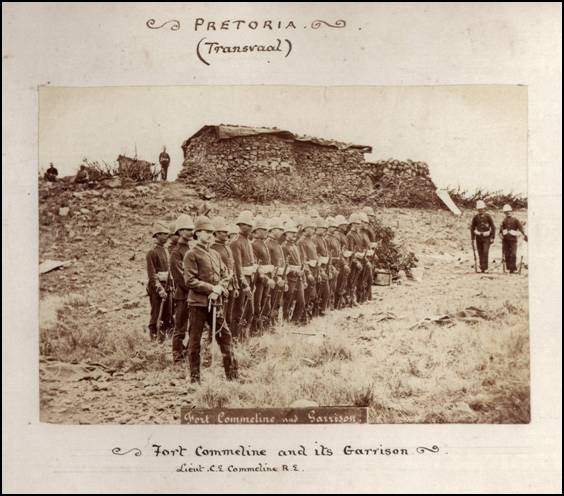
Figure 5. Fort
Commeline, Pretoria, South Africa.
(Photograph
courtesy of Fred Larimore)
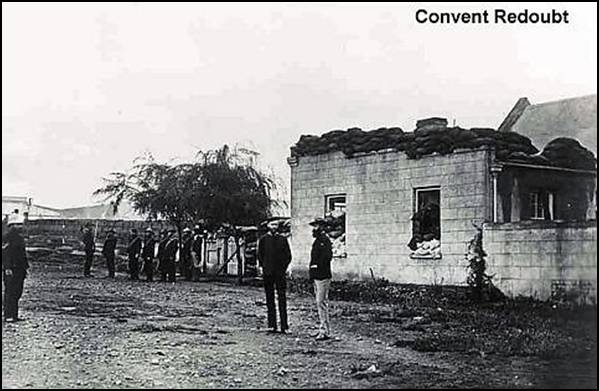
Figure 6. Convent Redoubt, Pretoria, South
Africa.
(Photograph courtesy of Wikipedia)
Major Le Mesurier planned for a sally by the garrison of the town to link up with the relief force under Major General Sir George Colley; a relief force which was thought to be approaching the town. Le Mesurier was confident that the defensive position was too strong for a frontal attack by the Boers and that the defenders were too vigilant to be taken by surprise.19
On the 21st of December 1880 a proclamation of martial law was read to an assembly of townspeople in Pretoria by the Colonial Secretary. At this meeting Major Le Mesurier explained that a withdrawal of the town’s population to the adjacent military camp was necessary as the town covered too large an area to permit it to be adequately defended and that possible street-fighting could bring about mistakes and catastrophes with many unintended casualties to the civilian population. Le Mesurier also was uneasy about population control, as it was felt that there were many sympathizers and relatives of the Boers within the town. In fact, while commanding the Pretoria Rifles, he sometimes expected that he would be shot in the back any day by a Boer sympathizer in the ranks of the unit.
Concentration of the people would give the military a ready means of controlling them. At the same time unity of action would be more feasible and it would be possible to introduce an effective system of rationing food and water.
Feverish activity marked the initial defensive preparations. A letter written by Major Le Mesurier, which subsequently fell into Boer hands, gave a detailed account of the tense situation in the town. In the letter Le Mesurier stated that he had been promised 400 men before nightfall on the 21st of December and with this force he would have to defend an area of two square miles.
During a period of a month of relative calm from the start of the Boer siege of Pretoria, the engineers in the garrison were employed on strengthening the defensive positions and looking to problems of water supply. Lieutenant Commeline established a fire brigade consisting of one large engine and two smaller ones manned by the native labour corps.
During the siege the garrison of Pretoria made three sallies which resulted in major clashes with the Boers on the 6th and 16th of January and the 12th of February 1881. Major Le Mesurier was present at the last of these actions, the attempt to destroy the Boer laager at Roodehuis (Red House). The attack was unsuccessful and a setback for the British forces. After being repulsed by the Boer force the retreating British force was hard pressed. Major Le Mesurier, with the volunteers, checked the advance of the enemy and enabled the retreating British force to return to the defensive perimeter.20 During these sorties by the garrison force the Royal Engineers occasionally used dynamite to create diversions. Dynamite also was used by the engineers for defensive minefields.21
In addition to commanding the 2nd Field Company, Royal Engineers, on the 18th of February 1882 Le Mesurier was promoted to the Brevet rank of Lieutenant Colonel and was appointed to command the Pretoria Rifles.22 In this capacity he organized and trained a battalion of civilian riflemen as part of the garrison for the defence of the town. This position created a number of administrative and political headaches for Le Mesurier. Grievances by both senior and junior officials in Pretoria were quite common.
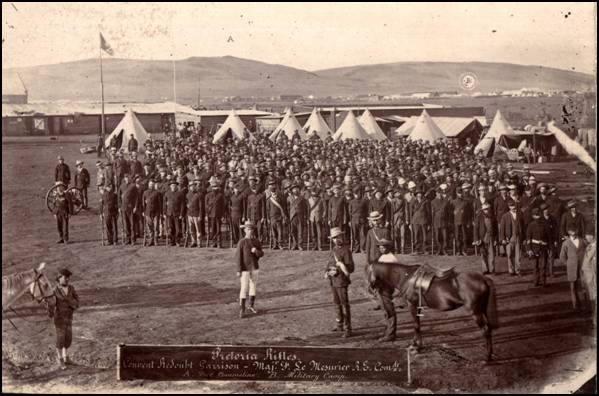
Figure 7. The Pretoria Rifles, Pretoria, South
Africa, c. 1880.
(Photograph courtesy of Wikipedia)
Captain R.K. Loveday of the Pretoria Rifles complained to Major Le Mesurier that “the greater part of the Head officials at [sic] living at the military camp in comparative ease – ease as compared to the life of those officials who serve as volunteers in this camp – who might also have procured for themselves appointments with merely nominal duties, which would have placed them out of danger, but they as men considered it their duty to shoulder their Rifles and become soldiers in reality – not in name only. . . ‘ Major Le Mesurier duly passed this protest on to the “Head officials,” and Captain Loveday was forced to withdraw his communication, which he was told, the Government considered an unbecoming and reprehensible dictation in matters entirely in the hands of the military.23
Strained relations between the military and the Law Department in Pretoria were also brought about by the fact that martial law was not fully applied to everyone equally. The Attorney General stated that he regretted to see that the military were forming their own legal opinions in some matters as they pertained to disciplining individuals within the town and camp and that some military officials were acting in a manner that was indefensible legally. He singled out Major Le Mesurier’s conduct in this regard as having been “vexatious and illegal.” Many of these problems had to do with the control of the jail which was part of the Convent Redoubt defensive works under Le Mesurier’s command.24
The news that an armistice had been reached between the British and the Boers reached Pretoria on the 15th of March 1881. The Martial Law proclamation in Pretoria was annulled on the 31st of March and within a few days thereafter all the volunteer units, including the Pretoria Rifles, were disbanded. Major Le Mesurier returned to is full-time duty as commander of the 2nd Company, Royal Engineers. He was mentioned in despatches for his good work while in command of Convent Redoubt and received words of praise from all who serve under him. Just how well Le Mesurier was like by his men was illustrated by the events that took place at the parade in Pretoria following the armistice. General Sir Evelyn Wood addressed the volunteers who had helped to defend the town. After his speech, and amid loud cheering, Major Le Mesurier was hoisted on the shoulders of his men and carried triumphantly to the European Hotel for refreshments.25 His men later presented him with a gold watch suitably inscribed.
After the conclusion of hostilities the priority of the engineer work was given to the re-establishment of communications with Heidelberg and the repair of telegraph lines to Natal.26 Major Le Mesurier and his men turned their efforts to these important tasks.
Le Mesurier was promoted to the rank of Temporary Lieutenant Colonel on the 18th of February 1881 while he was still serving in Pretoria.27 He returned home shortly after March of 1882 and on the 1st of July 1883 he was promoted to the permanent rank of Lieutenant Colonel while stationed at Sheerness in Kent.
Sheerness (1882-1885)
The major military installation at Sheerness was Garrison Point Fort and in all probability this is where Le Mesurier was posted in 1882. Garrison Point Fort was an artillery fort situated at the end of the Garrison Point peninsula at Sheerness on the Isle of Sheppey in Kent. Built in the 1860s in response to concerns about a possible French invasion, it was the last in a series of artillery batteries that had existed on the site since the mid-16th century. The fort's position enabled it to guard the strategic point where the River Medway meets the Thames.
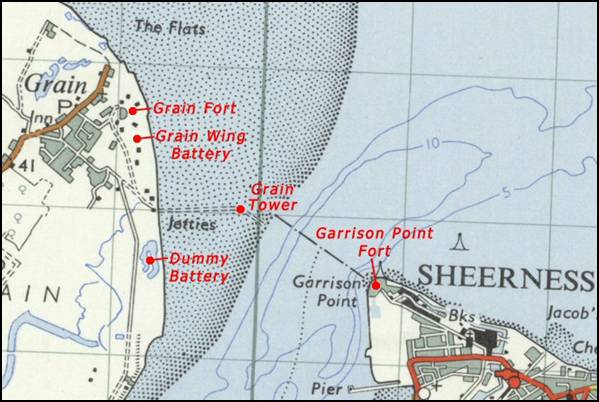
Figure 8. Sheerness and Garrison Point Fort.
(Map
courtesy of Wikipedia)
Garrison
Point Fort was initially armed with 9-inch and 10-inch rifled muzzle
loader (RML) guns. By 1880 its armament had been expanded to include
9-inch, 10-inch, 11-inch and 12.5-inch RMLs. A Brennan torpedo
station, used to launch wire-guided torpedoes, was added to the
fort's structure in 1884 and this station was operated by Royal
Engineers Submarine Miners. While Le Mesurier’s specific assignment
at Sheerness is not known for certain, his work most likely was
associated with the Garrison Point fort.
Sudan (1885-1886)
In 1885 Lieutenant Colonel Le Mesurier joined the Sudan Expedition along the Red Sea Littoral at Suakin. He joined the expedition as a replacement for Colonel Charles Brisbane Ewart28 as the Commander Royal Engineers on the lines of communication for the campaign. The Royal Engineers units in the Sudan Expedition at this time included:
Telegraph Battalion (one mounted section)
10th Railway Company
11th Field Company (a mounted detachment)
17th Field Company
24th Field Company
Balloon detachment
Lieutenant Colonel Le Mesurier was responsible for very extensive engineering works of varied character while serving in this capacity. Under his direction the Royal Engineers constructed defensive zeribas, defensive posts at Suakin, Hasheen, Otao and Tambouk, clearance of dense brush for field of fire, ground preparation for railway construction, development of water supply, and in general supported the army in the field by numerous engineer works.29 For his outstanding service Lieutenant Colonel Le Mesurier was mentioned in the despatch of Lieutenant General Sir Gerald Graham (ex-Royal Engineers), dated the 30th of May 1885. This despatch subsequently was published in the London Gazette dated the 25th of August 1885. Le Mesurier also received the Egypt 1882 medal with clasp [SUAKIN 1885] and the Khedive’s Star dated 1884-6.
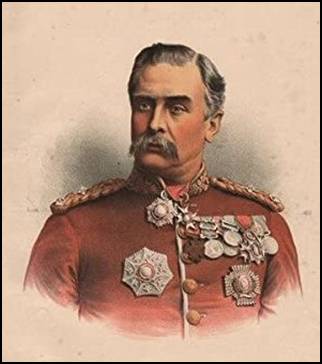
Figure 9. Lieutenant General Sir Gerald Graham,
VC, GCB, GCMG.
(Image courtesy of Wikipedia)
Ireland (1886-1888)
Following the end of the campaign in the Sudan Lieutenant Colonel Le Mesurier returned to Great Britain and was assigned as the Commander Royal Engineers of the large Cork district in Ireland. He was promoted to the rank of Temporary Colonel on the 18th of February 1886, followed shortly thereafter, on the 9th of March 1886, by a promotion to the rank of Colonel. In 1887 he was elected to be a Member of the Institution of Electrical Engineers.
His assignment in Ireland kept him very busy, but with boundless energy he found time to get up at 5 a.m. every morning to cut out a tennis court on the side of a hill near his home, shifting all the earth and completing the court with his own hands. During this same period he found time to study and earn the degree of Bachelor of Laws (LL.B.) from the University of London and to qualify as a barrister of the Inner Temple.
Extended Leave (1888-1889)
On the 1st of July 1888 he completed five years’ service as a Regimental Lieutenant Colonel and was temporarily placed upon half-pay. At this point he began to travel extensively in Iceland and Ireland. While in Iceland he walked 50 miles a day for six consecutive days and tramped all across the island.30 This feat certainly was testimony to his good health and physical condition.
Ireland (1889-1894)
Colonel Le Mesurier returned to his military duties on the 16th of September 1889 when he was appointed to the position of Chief Engineer for Ireland.31 It was while serving in this position that Lord Wolseley became the Commander-in-Chief in Ireland. Lord Wolseley befriended Le Mesurier and developed a deep respect for his engineering abilities.
On the 3rd of June 1893 (Birthday Honours List) Colonel Le Mesurier was made an Ordinary Member of the Military Division of the Third Class, or Companion of the Most Honourable Order of the Bath (C.B.). He retired from the Army on the 17th of March 1896.
__________________________________________________________________________
The following sections are presented in tabular form to summarize Le Mesurier’s promotions, appointments, military training and qualifications and the medals that he was awarded during his time in the Army. They are provided to give the reader easy access to these aspects of his military career. The tables are followed by sections dealing with his marriage, personal information and post-service life.
__________________________________________________________________________
6. PROMOTIONS AND APPOINTMENTS
Frederick Augustus Le Mesurier received the following promotions during his time in service:
Date of Promotion or Appointment |
Rank or Position |
1 October 1857 |
Commissioned, Lieutenant, Royal Engineers |
11 July 1867 |
Promoted Second Captain, changed to First Lieutenant |
5 July 1872 |
Promoted Captain, backdated to 11 July 1867 |
1 October 1877 |
Promoted Major |
18 February 1882 |
Appointed Brevet Lieutenant Colonel |
1 July 1883 |
Promoted Lieutenant Colonel |
18 February 1886 |
Promoted Colonel |
MILITARY TRAINING AND QUALIFICATIONS
Military Training: Research into the military service of Frederic Augustus Le Mesurier indicates that his only formal military training was at the Royal Military Academy, Woolwich and the School of Military Engineering at Chatham.
Qualifications: Le Mesurier earned the following qualifications during his time in service.
Date |
|
1861 |
Superintendent of Public Works |
1 May 1869 |
Assistant Instructor in Army Signalling |
1875 |
Inspector of Army Signalling |
1875 |
Commander, Royal Engineers Field Company |
1876 |
Deputy Assistant Quartermaster General for Signalling |
1880 |
Commander Royal Engineers |
1880 |
Commander, Volunteer Rifle Battalion |
1889 |
District Chief Engineer |
MEDALS, AWARDS AND DECORATIONS
Colonel Le Mesurier received the following medals, awards and decorations during his time in service:32
|
|
|
|
Medal or Award |
|
||
Companion of the Order of the Bath (Military Division) (C.B.) |
|
||
Egypt 1882 Medal with clasp [SUAKIN 1885] |
|
||
Khedive’s Star 1884-1886 |
|
||
9. SUMMARY OF SERVICE
Colonel Le Mesurier retired from Army on the 17th of March 1896. His total service was reckoned as shown in the tables below:
Location |
|
Chatham, Kent |
1857 - 1861 |
Trinidad |
1861 - 1863 |
Ireland |
1863 - 1869 |
Chatham, Kent |
1869 - 1875 |
Bermuda |
1875 - 1876 |
Aldershot, Hampshire |
1876 - 1880 |
Pretoria, South Africa |
1880 - 1882 |
Sheerness, Kent |
1882 - 1885 |
Suakin, Sudan |
1885 - 1886 |
Ireland |
1886 - 1888 |
On Leave (Ireland and Iceland)(2) |
1888 - 1889 |
Ireland |
1889 - 1894 |
Home Service(3) |
1894 - 1896 |
Location |
Period of Active Service |
Service Abroad |
32± years |
Home Service |
6± years |
Total Service:(4) |
38 years, 5 months and 17 days |
TABLE NOTES:
In some cases in the narrative precise dates are given for his postings; however, in many cases only the years have been stated as approximate dates.
His period on extended leave from 1888 to 1889 has been counted as Home Service, although he did spend some time in Iceland during that period.
His location during this period of Home Service was not determined during the course of this research.
His total service has been calculated based his date of commissioning (1 October 1857) and his date of retirement (17 March 1896).
10. POST SERVICE LIFE
After his retirement from the Army, Frederick Augustus Le Mesurier and his family took up residence in St. Giles, Oxfordshire. He immediately became involved in social programs to benefit the less fortunate and took a position as manager of the Oxford Labour Yard for unemployed men. The 1901 Census of England shows the composition of the family as follows:
1901 Census of England
Address: 31 St. Margaret’s Road, Oxford. |
|||||
Name and Surname |
Relation |
Marital Status |
Age |
Profession or Occupation |
Birthplace |
Frederick A. Le Mesurier |
Head |
Married |
62 |
Retired Colonel Royal Engineers Barrister at Law |
Newbury, |
Louisa A. Le Mesurier |
Wife |
Married |
66 |
|
Ireland |
Lisa S. Le Mesurier |
Daughter |
Single |
29 |
|
New Brompton, |
Hannah Russell |
Servant |
Single |
25 |
Cook |
Eynsham, |
Ada Reeves |
Servant |
Single |
18 |
Housemaid |
Hinton Waldrist, |
Between
1901 and 1911 there were many changes in the Le Mesurier family, most
of which have previously been discussed. His nephew Frederick Henry
Stewart had been commissioned a 2nd Lieutenant in The
Border Regiment in 1902, thereby carrying on the military tradition
of the Le Mesurier family. His youngest brother, George Frederick,
died in Gloucestershire in 1904 and in that same year young Frederick
Henry Stewart was promoted to the rank of Lieutenant. In 1906 his
youngest son, Eugene, passed away in Sevenoaks, Kent and in early
1907 his son Frederick went off to serve with the Sierra Leone
Battalion of the West African Field Force.
The 1911 Census of England and Wales has the Le Mesurier family living at the same address as in 1901 with some changes in domestic servants.
1911 Census of England and Wales
Address: 31 St. Margaret’s Road, Oxford. |
|||||
Frederick Augustus |
Head |
Married |
72 |
Retired Colonel |
Newbury, |
Louisa Le Mesurier |
Wife |
Married |
76 |
|
Westport, |
Lisa S. Le Mesurier(2) |
Daughter |
Single |
39 |
|
New Brompton, |
Harriet Stevens |
Servant |
Single |
46 |
Nurse(3) |
Williamscott, |
Esther Garner |
Servant |
Single |
21 |
Cook |
Northchurch, |
Alice Nipress |
Servant |
Single |
19 |
House Parlourmaid |
Islip, |
TABLE NOTES:
Apparently Colonel Le Mesurier had given up the practice of law.
Lisa, now a 39-year old spinster, is still living with her parents.
The need for a Nurse in the household has not been determined. Could Lisa have had health problem or was the nurse’s duties required for Louisa Le Mesurier. The latter seems most likely as Louisa Le Mesurier died in Headington, Oxfordshire on the 10th of April 1912, a little over a year after the census was taken. She was buried on the 12th of April 1912 at Wolvercote Cemetery in Oxford.
Colonel Le Mesurier lived through the years of the Great War of 1914-1918, but he was destined to suffer one more tragedy in his life. His son, Frederick Neil, was off to the Western Front with his regiment in November of 1914. After 5 months he was killed in action at Ypres on the 25th of April 1915. On this very same day his nephew, Frederick Henry Stewart Le Mesurier, landed at Gallipoli with the 1st Battalion of The Border Regiment. Of course Colonel Le Mesurier was not aware of this.
Frederick Augustus Le Mesurier died on the 9th of June 1926 at Headington, Oxfordshire at the age of 87. He was still living at 31 St. Margaret’s Road in Oxford. The Probate Calendar for 1926 shows his will was filed for probate in London on the 7th of September 1926 living all his effects to “Lisa Sibella Le Mesurier, spinster. His effects amounted to £852-0s-9d, or about $75,000 US in 2020 currency.
Lisa live on until the 15th of July 1948 when she died at the age of 76, still owning the house at 31 St. Margaret’s Road in Oxford. He died at The Regent Nursing Home on Moreton Road in Oxford. Her will was filed for probate in Oxford on the 24th of August 1948 with her effects going to Eileen Mary Simms, the wife of one Gerald Simms. These effects amounted to £14,132-14s-4d (about $705,000 US in 2020 currency), which must have included her house.
Lisa was buried with her parents at Wolvercote Cemetery in Oxford on the 19th of July 1948. The Register of Graves for Wolvercote Cemetery shows that the Le Mesurier grave, father, mother and daughter is marked E2100.33
11. FAMILY, MARRIAGE AND PERSONAL INFORMATION
This section deals primarily with Frederick Augustus Le Mesurier’s immediate family and those more distant relatives who served in the military. A few members of his family who had no military experience also are included because of some interesting experiences in their personal lives.
Frederick Augustus Le Mesurier four brothers, three sons, two grandsons, ten nephews and eleven great nephews. Of these 30 men, eleven served with the Colours. Four were killed in action or died on active service.
The Parents of Frederick Augustus Le Mesurier
Frederick Augustus Le Mesurier’s father, Frederick Henry Le Mesurier (1796-1865), was born at Guernsey on the Channel Islands on the 1st of September 1796. He was the son of Peter Le Mesurier (1750-1803) and Mary Le Mesurier (1757-1800). His brother was Lieutenant General John Le Mesurier, the late Governor of Alderney.
Frederick entered the Navy on the 13th of January 1809 on board the HMS Daphne, under Captain Philip Fipon. Daphne was stationed in the Baltic. As a Midshipman he served aboard HMS Victory, also in the Baltic, under Sir James Saumarez. He served aboard Victory until March of 1812. He then sailed for the East Indies aboard the frigate Theban under Captain Stephen Thomas Digby, which when in the China Sea the following September had the misfortune to be dismasted in a typhoon. On his return to England with Captain Digby aboard HMS Cornwallis, Mr. Le Mesurier, in October of 1813, joined HMS Amphion under Captains James Pattison Stewart and John Brett Purvis and, until the close of the American war, was employed at Bermuda. For a short period in the summer of 1815, in May of which year he passed his examination, he was on duty at Portsmouth aboard HMS Prince, serving under Captain Edmund Boger. In July of 1816 he was appointed Admiralty-Midshipman of HMS Fury. He served on Fury at the bombardment of Algiers.
HMS Fury was ordered by the Royal Navy on the 5th of June 1813 from the yard of Mrs Mary Ross, at Rochester, Kent, laid down in September, and launched on 4 April 1814. Fury saw service at the Bombardment of Algiers on the 27th of August 1816, under the command of Constantine Richard Moorsom. The Bombardment of Algiers was an attempt on the 27th of August 1816 by Britain and the Netherlands to end the slavery practices of Omar Agha, the Dey of Algiers. An Anglo-Dutch fleet under the command of Admiral Edward Pellew, 1st Viscount Exmouth bombarded ships and the harbour defences of Algiers. He was awarded the Naval General Service Medal 1793-1840 with clasp [ALGIERS] for his service.
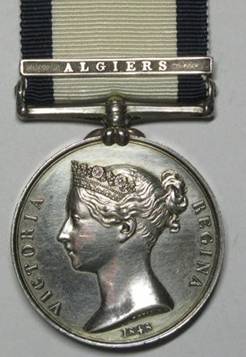
Figure 10. The Naval General Service Medal 1793-1840 with
Clasp [ALGIERS].
(Photograph courtesy of Corbitts Medals)
HMS Fury had an interesting history in the years after Le Mesurier served aboard her. Between November of 1820 and April of 1821, Fury was converted to an Arctic exploration ship and re-rated as a sloop. Commander William Edward Parry commissioned her in December 1820, and Fury then made two journeys to the Arctic, both in company with her sister ship, Hecla.
Her first Arctic journey, in 1821, was Parry's second in search of the Northwest Passage. The farthest point on this trip, the perpetually frozen strait between Foxe Basin and the Gulf of Boothia, was named after the two ships: Fury and Hecla Strait.
On her second Arctic trip, Fury was commanded by Henry Parkyns Hoppner while Parry, in overall command of the expedition, moved to Hecla. This voyage was disastrous for Fury. She was damaged by ice at the start of the second season and was eventually abandoned on the 25th of August 1825, at what has since been called Fury Beach on Somerset Island. Her stores were unloaded onto the beach and later came to the rescue of John Ross, who travelled overland to the abandoned cache when he lost his ship further south in the Gulf of Boothia on his 1829 expedition.
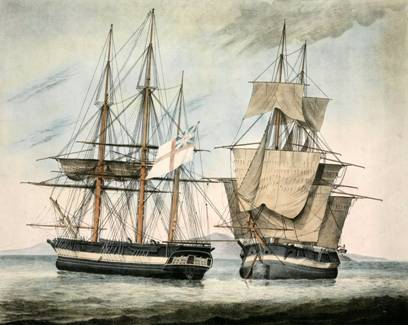
Figure 11. HMS Fury and Hecla.
(Image courtesy of
Wikipedia)
NOTE: His Majesty's Discovery Ships Fury and Hecla Hand coloured lithograph depicting the Fury and Hecla, which took part in 1824 and 1825 in Parry's attempt to discover a N/W passage from the Atlantic to the Pacific. Inscribed: "His Majesty's Discovery Ships Fury [and] Hecla". The Fury is on the left, Hecla on the right. His Majesty's Discovery Ships Fury and Hecla
After his service aboard Fury, Le Mesurier was confirmed in the rank of Lieutenant on the 12th of November 1824. He served as Acting-Lieutenant, aboard HMS Severn under Captain the Honorable Frederick William Aylmer, on HMS Myrmidon under Captain Robert Gambier, on HMS Venguer under Captain Frederick Lewis Maitland, on HMS Niemen under Capt. Edward Reynolds Sibley, on HMS Ramillies under Captain Edward Brace, on the frigate HMS Andromache under Captain Joseph Nourse, and on HMS Espiegle under Captain Isham Fleming Chapman. He served on these ships on the Home, Mediterranean, American, and Cape of Good Hope stations.
Le Mesurier continued to serve on HMS Espiegle as Lieutenant until July of 1825, when, being at the time at the Mauritius, he was compelled to be invalided and to return to England in because of the repeated attacks of a severe ailment. From the 10th of April 1826 until May of1827, Mr. Le Mesurier served at Plymouth aboard HMS Britannia, the flag-ship of Sir James Saumarez.
Frederick Henry Le Mesurier married Jane Catherine Maunsell (1800-1882), the only daughter of Thomas Cecil Maunsell, Esquire of Thorpe Malsor, Northamptonshire.34 Frederick Henry Le Mesurier died on the 8th of October 1865 in Chipping Sodbury, Gloucestershire. Jane Catharine Le Mesurier died on the 14th of September 1882 in Tormarton, Gloucestershire.
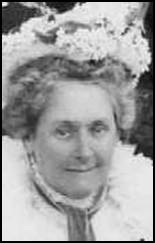
Figure 12. Supposed Photograph of Jane Catharine Le
Mesurier, c. 1870.
(Photograph courtesy of various family
trees)35
The
Children of Frederick Augustus Le Mesurier
Frederick
Augustus Le Mesurier married Louisa Anne Browne (1835-1912) in Dover,
Kent on the 31st of January 1866. Louisa was the daughter
of John Denis Browne (1798-1862), a Member of Parliament (MP) for
County Mayo, Ireland. Frederick and Louisa had five children; Eugene
(1866-1906), Sydney (1869-1953), Lisa Sibella (1872-1948), Sibyl Mary
(1874-1946) and Frederick Neil (1875-1915). Two of his sons served in
the military, one in the Army and one in the Royal Marines (see Annex
No. 1).
Eugene Le Mesurier
Eugene Le Mesurier was born in Canterbury, Kent on the 27th of November 1866 and was baptized on the 4th of February 1897. In 1871 he was residing with his parents in Gillingham, Kent and in 1881 he was a boarder at school in Hougham, Kent.
On the 1st of September 1885 Eugene Le Mesurier was commissioned a Lieutenant in the Royal Marine Light Infantry.36 In 1896 he was serving in Allahabad, India where he married Lilian Florence Bruce (1873-1963) on the 10th of December of that year. He continued to serve in India until at least 1902. Eugene and Lilian had a son, Roderick Le Mesurier (1905-1971) who was born in Steyning, Sussex on the 25th of January 1905.
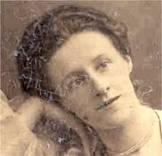
Figure 13. Lilian Florence Le Mesurier.
(Photograph
courtesy of johntyner family tree)
Eugene Le Mesurier died in Sevenoaks, Kent on the 29th of May 1906 at the age of 39.
Sydney Le Mesurier
Sydney Le Mesurier was born in New Brompton (Chatham), Kent on the 29th of June 1869. In 1871 he was residing with his parents in Gillingham, Kent. He attended St. Mark’s School in Windsor and he matriculated at Exeter College in Oxford University on the 17th of October 1888.37
Reverend Sydney Le Mesurier, M.A. became the Vicar of Westerham in the Sevenoaks district of Kent in 1900 and he served in that position until 1920. He married Una Morton (1871-1902) on the 24th of January 1901 at St. Jude’s Church in Mildmay Grove, a suburb of London. Una gave birth to twin daughters, Una Joyce (1902-1995) and Barbara Mary (1902-1989) on the 19th of July 1902 at Stoke Newington, London. Una Morton died in July of 1902, perhaps as result of a difficult childbirth.
Sydney married a second time on the 22nd of July 1905. His bride was Evelyn Gertrude Hunter (1867-1948). They married at St. Andrew’s Church in St. Marylebone, London. Sydney and Evelyn had a son, Richard Eugene (1906-1949), who was born in Regents Park, London in April of 1906. Richard died on the 6th of March 1949 in Aylesbury, Buckinghamshire.
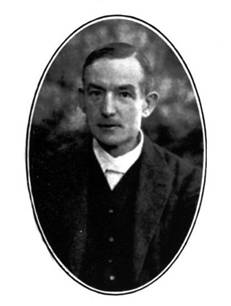
Figure 14. The Reverend Sydney Le Mesurier, M.A., Vicar of
Westerham, 1900-1920.
(Photograph courtesy of Wikipedia)
Evelyn Gertrude Le Mesurier died in Worthing, Sussex on the 11th of February 1948. Sydney Le Mesurier also died in Worthing on the 13th of January 1953 at the age of 83.
Frederick Neil Le Mesurier
Frederick Neil Le Mesurier was born in Brighton, Sussex on the 6th of May 1875. He was educated at Marlborough College and was commissioned a Second Lieutenant in the Royal Dublin Fusiliers on the 28th of September of 1895 and was promoted to the rank of Lieutenant on the 1st of October 1897.38
Frederick served in the Mounted Infantry of his regiment in the early part of the South African War in 1899 and was taken to Pretoria as a prisoner by the Boers. He was held at the Model School prison camp, the same place from which the young Winston Churchill made his famous escape. Sometime after Churchill’s escape, Lieutenant Le Mesurier made his own successful bid for freedom along with Captain Haldane of the Gordon Highlanders and one other man and after an arduous trek, with a sprained ankle, he finally reached Delgoa Bay.
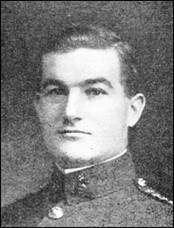
Figure 15. Captain Frederick Neil Le Mesurier, Royal Dublin
Fusiliers.
(Photograph courtesy of various family trees)
After rejoining his regiment Le Mesurier developed a bad fever and was invalided home. He was promoted to the rank of Captain on the 5th of March of 1900 and returned to South Africa in the same year where he took part with his regiment in the operations in the Transvaal between December of 1900 and May of 1901 and again from January to May of 1902. He was mentioned in despatches in the London Gazette of 10 September 1901.
Captain Le Mesurier was seconded from his regiment in 1904 on appointment to the Sierra Leone Battalion of the West African Field Force (W.A.F.F.) and in that year he took part, as Second in Command of the battalion, in operations against the Kissis. During a retirement from enemy forces when commanding the rearguard, and on his own initiative, he halted in a favorable position and lay in ambush until the enemy came within a few yards of him. He charged the pursuing enemy force and defeated them in a hand-to-hand fight. He was appointed a Temporary Major on the 20th of February 1907 while serving with the W.A.F.F.
Le Mesurier married Rachel Whitford Gilham (1874-1941) on the 4th of January 1906 in Bushey, Hertfordshire while on home leave from Sierra Leone. He retired from the Army in October of 1910 and continued to work in Sierra Leone as an Assistant Commissioner in the Colonial Service.
On the outbreak of the Great War Captain Le Mesurier rejoined the Army and was posted to a company in the 2nd Battalion of his old regiment. This was to be a fatal decision. After joining his battalion in France on the 8th of November 1914 he served in the trenches at St. Ives throughout the winter of 1914/1915. In April of 1915 his division was ordered to relieve the Canadians who had been gassed in the Ypres salient. On the 25th of April 1915 he led his company in the attack on St. Julien until they were halted at the village by a wire entanglement and were enfiladed by machine gun fire. Captain Le Mesurier ordered his men to lie down while he went forward to cut a way for them through the wire. It was while making a second attempt to carry this out that he was killed.39
In an article entitled What the Irish Regiments Have Done Captain Le Mesurier’s actions at St. Julien are described in more detail;
“At 150 yards from the German trenches the order is given to fix bayonets. Two officers – Captain Le Mesurier and a Lieutenant, rush up in advance to cut the barbed wire. They are killed on the spot. Others take their places, and man after man is shot down in an endeavor to clear away the hellish obstacle. In vain. There has been no proper artillery preparation for the attack, and to charge the trenches with the wires still standing would mean annihilation for the regiment. And in these terrible moments of waiting the men are lying out in the open, 150 yards from the Germans, who rake them with rifle fire, with machine guns, with shrapnel . . .”
For his service, Captain Frederick Neil Le Mesurier was awarded the following medals:
Queen’s South Africa Medal, 1899-1902 with clasps [TALANA] [ORANGE FREE STATE] [TRANSVAAL] [CAPE COLONY].
King’s South Africa Medal 1901-02 with clasps [SOUTH AFRICA 1901] [SOUTH AFRICA 1902].
Africa General Service Medal 1902-56 with clasp [KISSI 1905].
1914 Star
British War Medal
Victory Medal
Mrs. Rachel Le Mesurier was presented with a Memorial Plaque to commemorate her husband’s death. She applied for his 1914 Star on the 2nd of December 1918 from her address on Bourne Place in Bushey, Hertfordshire.40 His death is commemorated as well by the Commonwealth War Graves Commission on the Ypres (Menin Gate) Memorial, Panels 44 and 46.
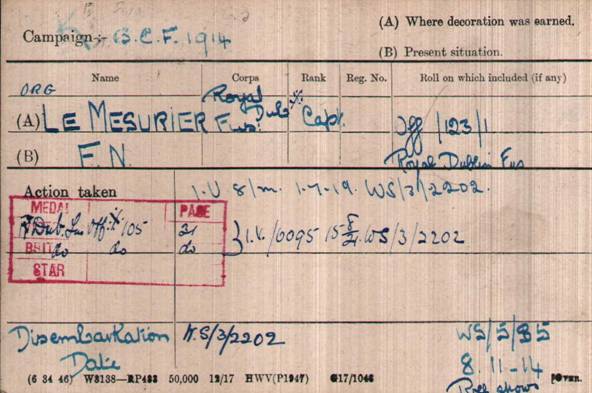
Figure 16. Great War Medal Index Card of Captain Frederick
Neil Le Mesurier.
(Image courtesy of Ancestry.com)
The Brothers of Frederick Augustus Le Mesurier
Cecil Brooke Le Mesurier
Cecil Brooke Le Mesurier, the brother of Frederick Augustus Le Mesurier, was born on the 15th of February 1831 in Brockworth, Gloucestershire. He was baptized in Brockworth on the 20th of March 1831.
Cecil attended the Royal Military Academy at Woolwich and as a Gentleman Cadet he was commissioned a Second Lieutenant in the Royal Artillery on the 19th of June 1850.41 On the 4th of June 1854 he married Nicolina Contessa Zancarol (1839-1921) in the garrison church on the island of Corfu, Greece. Cecil and Nicolina had five children; Cecil John Reginald (1855-1932), Katharine Irene (1857-1942), Harry Brooke (1859-1941), George Cyril Aubrey (1866-1893) and Eva Adelaide Helen (1871-1953).
Cecil Brooke Le Mesurier had a successful military career with promotions as shown below:
To First Lieutenant, 16 February 1852.
To Second Captain, 24 January 1857.
To Captain, 28 July 1864.
To Major, 5 July 1872.
To Lieutenant Colonel, 24 July 1875.
To Brevet Colonel, 24 July 1880.
To Colonel, 30 November 1881.
In Her Majesty’s Birthday Honours List of 21 June 1887, Colonel Le Mesurier was made a Companion of the Most Honourable Order of the Bath (Military Division, Third Class). On the 8th of November 1899 Colonel Cecil Brooke Le Mesurier, C.B., late R.A. was granted “Her Majesty’s Royal license and authority to accept and wear the Insignia of the Gold Cross of the Royal Order of the Redeemer conferred upon him by His Majesty the King of the Hellenes in recognition of services rendered by him in relief work in Greece amongst fugitive families upon Thessaly and Crete.”42 The fugitives referred to undoubtedly were created by the Greco-Turkish War of 1897.
The Order of the Redeemer has five classes; Grand Cross, Grand Commander, Commander, Gold Cross and Silver Cross in order of precedence. The original decree for the award of this Order set specific limits on the number of awards. While there was no limit on the number of Silver Crosses that could be awarded, Gold Crosses were limited to 120, Commanders to 30, Grand Commanders to 20, and Grand Crosses to 12. Foreign recipients, as well as princes of the Greek royal family, did not count to these totals, so the Order could be conferred on Le Mesurier for his service to Greece.
Cecil Brooke Le Mesurier died in Virginia Water, Surrey on the 6th of February 1913 9 days before his 82nd birthday.43 One of his children, his son George Cyril Aubrey Le Mesurier predeceased him in 1893.

Figure 17. Gold Cross of the Order of the
Redeemer.
(Image courtesy of Wikipedia)
The Sons of Cecil Brooke Le Mesurier
Cecil Brooke Le Mesurier’s two sons, Cecil John Reginald and Harry Brooke had children who served in the Second World War (see Annex No. 2).
Harry Brooke Le Mesurier
Harry Brooke Le Mesurier, B.Sc., F.G.S. was a Mining Engineer. He had two sons who served in WW2, George James Brooke and Basil Guy.
George James Brooke Le Mesurier (1886-1942), Army Number 108057, was a Captain in the Royal Engineers. He died on the 11th of December 1942, age 56, and was buried in the Stanley Military Cemetery (1. A. 50.) in Hong Kong.
Basil Guy Le Mesurier (1889-1945), Army Number 108056, was a Captain in the Royal Army Service Corps. He died on the 13th of July 1945, age 56, and was buried in the Kranji War Cemetery (14. B. 15.) in Singapore, Malaya. It should be noted the at the Army Numbers of George and Basil are only one digit apart, 108057 and 108056, respectively, indicating that they either enlisted or were commissioned on the same day.
Cecil John Reginald Le Mesurier
Cecil Brook Le Mesurier’s son, Cecil John Reginald Le Mesurier, did not serve in the military, but he was a Civil Servant with the Colonial Office in Ceylon. His story is worth discussing here because of the notoriety it caused while he was in Ceylon. The following is from a publication entitled “Fragile Identities: The Colonial Consequences of CJR Le Mesurier in Ceylon,” which details the problems he encountered while serving there.
“In the colonial narrative there are conforming types that constantly recur to the point of parody. As places of periphery, colonies attracted the existentially displaced and those attempting to remake themselves, what Talleyrand called ‘restless men who need projects and unfortunate men who need hope’. Most fought encroachment by the other. Some embraced it with enthusiasm or bent to the opportunities afforded, inviting retributive reaction from the prevailing imperial norm. This shifting sense of self, of fragile identity, often provided tableaux more revealing than ever intended, disclosing dramas of hyperbole and grandiosity as inflated as the colonial impulse itself. Whatever the personal performance, though, enactment was choreographed within imperial parameters of ideology and policy, some explicit, most implicit and unvoiced. Assumptions of race and religion, and marriage and morality are recurring colonial emphases as are the significant ideological and legal justifications of land policy at the heart of colonial acquisition. The multilayered life of Cecil Le Mesurier touches on a startling array of these colonial themes, none more significant than in the area of land policy and the ideological and legal justifications that sustained its pursuit, assumptions derived from the North American experience and elaborated elsewhere, not only in Ceylon but particularly in Australia. His land dealings and subsequent litigious machinations eloquently encapsulated the evolving assumptions of this core colonial preoccupation. Le Mesurier's exaggerated effrontery was handled starkly by the authorities.
In January 1896 the Acting Governor of Ceylon Sir Edward Noel Walker wrote to the Assistant Government Agent and District Judge at Matara on Ceylon's south coast, Cecil Le Mesurier, ordering his dismissal. His offence was apparently simple - Mr Le Mesurier had converted to the Mohammedan faith and married. At first sight it would appear all the late nineteenth century articles of racist and religious intolerance had been brought to bear, the transgression of boundaries that would form the basis of a 'scandal' meriting dismissal. Deciphering such a narrative is often made clearer if the thoughts concealed in secret dossiers are revealed to the present, for few files lie within the embargo of "Secret and Confidential" unless considered extremely sensitive or likely to embarrass.
Le Mesurier entered the cloisters of secrecy when he wrote to the Secretary of State for Colonies protesting his dismissal, backed up by the dreaded 'questions in the House'. He obviously had friends and some influence. He had also written to his "Dear Brother", the Mohammedan member of the Legislative Council, Abdul Rahiman, an early Ceylonese nationalist, seeking his support and calling his dismissal "an attempt by Christians to dishonour the faith of Islam". He signed with his new name Abdul Hamil. Though he had offered initial support, as the controversy erupted Abdul Rahiman wilted and turned his correspondence over to the Governor. He now wanted it known that Le Mesurier was dismissed "not for changing faith but of his own misconduct". He hoped the Governor would "give an elaborate reply" in the Legislative Council, because the "bulk" of the island's Muslims are "unpolished and fond of talking idle talk". Rahiman's obsequious attempt to ingratiate himself - on one occasion he asks the Governor "to pardon one for disturbing your valuable time in such a worthless gnat" (sic) - shows all too often the underside of colonial relations despite public adherence to 'nationalist' ideals. He was, after all, an appointed, not an elected member of the Legislative Council and thus reliant on the continuing good favour of the Governor, and the Governor was happy to protect his informant by classifying his disclosures as 'secret'. The sequence of events leading up to Le Mesurier's dismissal lie in his conduct as a public servant where he had become a thorn in the side of government in a manner that was to leave some peculiar and lasting impressions on law and governance in Ceylon. Cecil John Reginald Le Mesurier was conceived in exaggeration and delivered into the world at Cephalonia in the Ionian Islands in 1855 to the "Greek princess" Nicolina Zancarol.”
In addition to the above cited scandal, Cecil John Reginald Le Mesurier also was involved in a divorce case while in Ceylon. In February of 1883 he had married a French woman in England and they were living in Ceylon. In July of 1892 while he was the Assistant Government Agent of the District of Matar, he brought suit against his wife for adultery in 1887, 1889, 1891 and 1892 with three different men.
It is not known just how much these “scandals” affecting the Le Mesurier family in general. Surely it affected the career of Cecil John Reginald. He was dismissed from Ceylon and moved to Australia where he worked as a solicitor and barrister.
Reginald Frederick Le Mesurier
Cecil John Le Mesurier’s son, Reginald Frederick Le Mesurier (1885-1946) served as a 2nd Lieutenant in the Royal Army Service Corps during the war. He was 61 years old when he died on the 17th of February 1946, so he was already middle-aged when he served in the war. At that age it is most likely that he did not see any active service abroad.
Thomas Maunsell Le Mesurier
Thomas Maunsell Le Mesurier, the second brother of Frederick Augustus Le Mesurier, was born in East Woodhay, Berkshire on the 8th of September 1834. On the 29th of February 1856, at the age of 21 years and 5 months, Thomas was commissioned an Ensign in the 36th Regiment of Foot (Hereford Regiment), without purchase. In 1856 when Thomas was commissioned, the 36th Foot was in Jamaica where the regiment lost a large number of men from an epidemic of yellow fever. It returned home to England in 1857. It is not known whether Thomas was in Jamaica when he was commissioned or whether he was in England at the time waiting to join the regiment.
The London Gazette of March 23, 1858 (p. 1533) shows that Ensign Thomas Maunsell Le Mesurier was promoted in the 36th Foot, without purchase, to the rank of Lieutenant, vice a Lieutenant named Macdonald who had been promoted and moved to the 18th Foot. The regiment spent a tour of duty in Ireland from 1860 to 1863, so Thomas could have been with the regiment there if he remained in the Army.
Thomas married Mary Ann Stuart Sheppard (1840-1905) on the 7th of January 1864 and beginning in December of 1864, Thomas and Mary began to have a long string of children, many born in South Africa. As the 36th Foot was serving in India in 1864, it would appear that Thomas resigned his commission and may have taken a position with the Colonial Office in South Africa. Precisely what he was doing in South Africa until at least 1870 is not known.
Thomas and Mary had seven daughters and six sons; Catherine Frances (1864-1940), Maude Marion (1866-1867), Walter Frederick (1867-1941), Ethel Maunsell (1869-1917), Ernest Cecil (1870-1932), Mary Constance (1872-1873), Thomas Gerald (1874-?), Frederick John (1875-1876), Muriel Jane (1876-1968), Harold Stuart (1877-1878), Arthur Boulger (1879-1902), Gertrude (1880-?) and Hilda Stuart (1881-1927). The names of the children that are underlined were born in South Africa between 1864 and 1870. Tragically, two of their daughters and two of their sons died within a year of their respective births.
Between 1872 and 1888 Thomas and Mary lived in London, Battersea, Surrey, Hillingon, Middlesex and Yalding, Kent. Thomas Maunsell Le Mesurier died in East Farleigh in the County of Kent on the 11th of August 1888, age 53.44
The 1888 Probate Calendar lists him as Thomas Maunsell Le Mesurier, Esq., so he may have been a Barrister at Law or held a degree in law or science. The calendar indicates that he was living at Scraces Barming, near Maidstone, Kent at the time of his death. His will was proved at the Principal Registry by his wife with his effects amounting to £1,534-4s (approximately $224,000 US in 2020 currency).
The Sons of Thomas Maunsell Le Mesurier
Thomas Maunsell Le Mesurier had four surviving sons; Walter Frederick, Ernest Cecil, Thomas Gerald and Arthur Boulger. None of them appears to have served in the military. However, Ernest Cecil Le Mesurier also had three sons, one of whom, Thomas Frederick (1897-1932) served in the Great War of 1914-1918 with great distinction (see Annex No. 3).
Thomas Frederick Le Mesurier
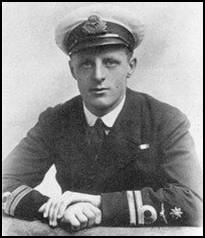
Figure 18. Lieutenant Thomas Frederick Le Mesurier,
RNVR, later Captain, R.A.F.
(Photograph courtesy of The
Aerodrome)
Thomas Frederick Le Mesurier was born in Shepherd’s Bush, London on the 6th of February 1897. He was educated at St. John’s College in Hurstpierpoint, Sussex. He enlisted on the 21st of September 1914 as an Ordinary Seaman in the Royal Navy Volunteer Reserve (RNVR) and was then commissioned a Temporary Sub-Lieutenant in the RNVR on the 20th of March 1915 and was confirmed in his rank of Flight Sub-Lieutenant in the Royal Naval Air Service (RNAS) on the 22nd of July 1915. His records show that he passed flying training at the Central Flying School at Upavon and was granted Royal Aero Club Certificate No. 2753 on the 17th of March 1916.
He was posted to “Hood Company” of the 2nd Reserve Battalion and then was transferred on the 22nd of July 1915 to the Royal Naval Air Service (RNAS) as a Probationary Flight Sub-Lieutenant and later a Flight Commander. He qualified as a pilot on the 17th of March 1916.

![]()
Figure 19. Flight Training Certificate.
(Image
courtesy of Ancestry.com)
Following his flying certification Le Mesurier was posted to No. 5 Squadron, RNAS and began flying the Airco DH.4 two-seater day bomber.45 He was promoted to Flight Lieutenant on the 31st of December 1916.
Le Mesurier’s first aerial victory came on the 3rd of June 1917 when, with Observer Flight Sub-Lieutenant R.G. St. John, he drove down out of control an Albatross D.III west of Bruges.
His second victory came on the 5th of June 1917 when he destroyed and destroyed two more Albatross D.IIIs over Snellegem and Diksmuide, with Observer Aerial Gun Layer H.S. Jackson. Le Mesurier was promoted to Flight Commander on the 30th of June 1917. He would share all his subsequent victories with H.S. Jackson, all over Albatross D.Vs, and occurring on the 19th of August, 11th of September and 15th and 21st of October.
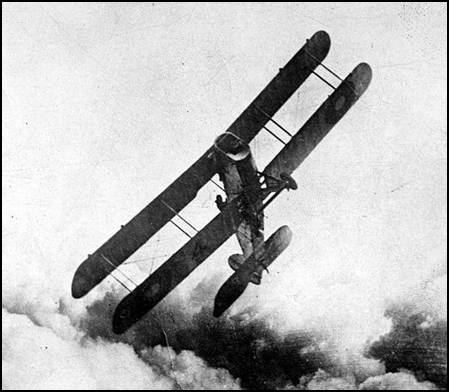
Figure 20. The Airco DH.4 Two-Seater Day
Bomber.
(Image courtesy of Wikipedia)
The following is a list of all his victories over enemy aircraft:46
No. |
Date |
Time |
Unit |
Aircraft |
Opponent |
Location |
1 |
3 Jun 1917 |
0500 |
5N |
DH.4 N5967 |
Albatross D.III |
West of Brugge |
2 |
5 Aug 1917 |
1800 |
5N |
DH.4 N5967 |
Albatross D.III |
Snelleghem |
3 |
5 Aug 1917 |
1802 |
5N |
DH.4 N5967 |
Albatross D.III |
Dixmude |
4 |
19 Aug 1917 |
0600 |
5N |
DH.4 N6005 |
Albatross D.V |
Southwest of Ostende |
5 |
11 Sep 1917 |
1100 |
5N |
DH.4 N5968 |
Albatross D.V |
Sparappelhoek |
6 |
15 Oct 1917 |
Not recorded |
5N |
DH.4 N5967 |
Albatross D.V |
East of |
7 |
21 Oct 1917 |
Not recorded |
5N |
DH.4 |
Albatross D.V |
Houttave |
On the 1st of April 1918 the RNAS and the Army’s Royal Flying Corps (RFC) were merged to form the Royal Air Force (RAF) and Le Mesurier’s rank of Flight Commander was changed to the RAF equivalent of Captain. He was transferred to No. 211 Squadron, RAF, 65 Wing (formerly No.11 Naval Squadron) at some point after the 10th of March 1918.
On the morning of the 26th of May 1918, Captain Le Mesurier and his observer, Second Lieutenant R. Lardner, were flying an Airco DH.947 (number D1693) on a test flight when they were engaged by German Marine Flak near Schoorbakke and suffered server damage to the aircraft. Le Mesurier managed to fly the stricken aircraft back towards his own lines, but crashed after the port wing folded up crossing over the trenches near Pervijze. The aircraft was completely wrecked, but was taken to No. 8 Air Park.
Unfortunately Lardner was killed instantly and Le Mesurier died later. He was 21 years old.
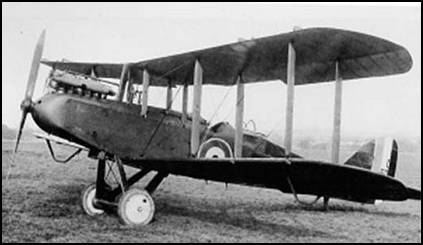
Figure 21. The Airco DH.9.
(Photograph
courtesy of Wikipedia)
NOTE: The death of Le Mesurier and Lardner is described differently by a researcher in one of Le Mesurier’s family trees.48 That researcher states that he and Lardner “died of injuries received accidentally, whilst piloting a DH.9, No. D1693, on a test with extra drift wires. If this is true it makes their deaths even more tragic.
For his service Captain Thomas Frederick Le Mesurier was awarded the Distinguished Service Cross (DSC) with two bars. The citations for the awards read as follows:
DISTINGUISHED SERVICE CROSS
Flt-Lieut. Thomas Frederick Le Mesurier, R.N.A.S.
For conspicuous work as a pilot of a bombing machine. He has taken part in fourteen raids and numerous fighter patrols
DISTINGUISHED SERVICE CROSS, First Bar49
Flt-Cdr. Thomas Frederick Le Mesurier, D.S.C., R.N.A.S.
For consistent skill and courage in leading his flight on bombing raids, particularly on the 28th July, 1917
NOTE: The death of Le Mesurier and Lardner is described differently by a researcher in one of Le Mesurier’s family trees.50 That researcher states that he and Lardner “died of injuries received accidentally, whilst piloting a DH.9, No. D1693, on a test with extra drift wires. If this is true it makes their deaths even more tragic.
DISTINGUISHED SERVICE CROSS, Second Bar51
Lieut. (temp. Capt.) Thomas Frederick Le Mesurier, D.S.C., R.A.F.
For gallantry and consistent good work. He has at all times displayed the utmost gallantry in action, and for his determination and skill has set a very fine example to the pilots of his squaderon. On the 23rd April 1918, in spite of bad weather conditions, he successfully dropped bombs on the Ostend Docks from a height of 800 feet amidst intense anti-aircraft and machine-gun fire. He also made valuable observations. He has taken part in many bomb raids, and has destroyed or driven down out of control serveral enemy machines.
Thomas Frederick Le Mesurier is buried in the Dunkirk Town Cemetery (IV.A.24). The inscription place on his headstone by his family reads:
he is not here
he has risen
on the wings
of resurrection
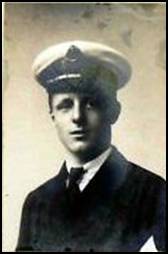
Figure 22. Thomas Frederick Le Mesurier, D.S.C. and 2
Bars.
(Photograph courtesy of The Channel Islands and the
Great War)

Figure 23. The Headstone of T.F. Le Mesurier in Dunkirk Town
Cemetery.
(Photograph courtesy of The Channel Islands and
the Great War)
Andrew Alfred Le Mesurier
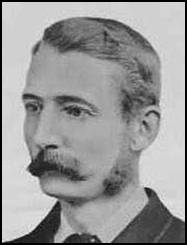
Figure 24. Andrew Alfred Le Mesurier.
(Photograph
courtesy of various family trees)
Andrew Alfred Le Mesurier was born in East Woodhay, Berkshire on the 19th of January 1837. According to the 1851 census he was residing in Wexham, Buckinghamshire.
His entry into the Army began with his commissioning as an Ensign in the 2nd West Yorkshire Artillery Volunteers on the 19th of January 1855. He subsequently gained a commission as an Ensign in the 14th Regiment of Foot (The West Yorkshire Regiment (Prince of Wales’s Own). On the 17th of August 1855 he was promoted to the rank of Lieutenant, without purchase, in the 14th Foot.52 He was promoted to the rank of Captain (on a date not determined) and then was appointed a Brevet Major. On the 15th of August 1877 he was promoted to the rank of Major, vice Brevet Lieutenant Colonel Grogan.53 On the 25th of May 1880 he was promoted to the rank of Lieutenant Colonel in the 14th Foot, vice Colonel F.B. Drew, C.B., who was placed on half-pay.54
In 1882 Lieutenant Colonel Le Mesurier transferred to another regiment by exchanging with another officer. On the 10th of June 1882 Lieutenant Colonel Reginald Whitting of The King’s (Liverpool Regiment) took command of The Prince of Wale’s Own (West Yorkshire Regiment), which Le Mesurier was commanding. Le Mesurier in turn took Whitting’s place as the commander of The King’s (Liverpool Regiment) on this same date.55 The reason behind this exchange is not known.
As far as it can be determined, Andrew Alfred Le Mesurier’s first, and perhaps only, active service was in Burma in 1885. The Third Burma War, as it was known, was a conflict that took place from the 7th to the 29th of November 1885, with sporadic resistance and insurgency continuing into 1887. It was the final of three wars fought in the 19th century between the Burmese and the British. The war saw the loss of sovereignty of an independent Burma under the Konbaung dynasty, whose rule had already been reduced to the territory known as Upper Burma, the region of Lower Burma having been annexed by the British in 1853, as a result of the Second Anglo-Burmese War. Le Mesurier’s 2nd Battalion of The King’s (Liverpool Regiment) was part of the original expeditionary force (Upper Burma Field Force), consisting of 9,034 fighting men, 2,810 native followers and 67 guns under Maj-Gen Harry North Dalrymple Prendergast. Le Mesurier’s battalion was in the 1st Infantry Brigade commanded by Brigadier General H. H. Foord. Battalions of the 21st and 25th Madras Infantry also were in the brigade.
For his service in this campaign, Le Mesurier was awarded the India General Service Medal 1854 with clasp [BURMA 1885-7].
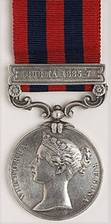
Figure 25. The India General Service Medal 1854 with Clasp
[BURMA 1885-7].
(Image courtesy of Wikipedia)
It is interesting to note that on the medal roll of the 2nd Battalion, The Liverpool Regiment (WO 100/69) Le Mesurier is listed as a Colonel. The Lieutenant Colonel of the battalion during the campaign was on Thomas George Crawley. The roll further indicates that Le Mesurier was “serving with the Regiment” and not at the “Depot.” The roll appears to have been prepared somewhere in the Bengal Presidency back in India following the end of the campaign.
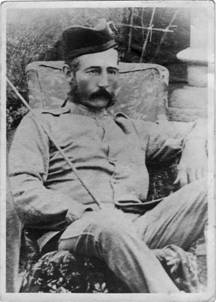
Figure 26. Colonel Andrew Alfred Le Mesurier, C.B., 2nd
Battalion, The King’s Liverpool Regiment.
(Photograph
from various family trees)
Andrew Alfred Le Mesurier married Kate Josephine Vyse (1848-1927) in Kussowlie, India on the 16th of September 1869. Andrew and Kate had the following children born in India; George Griffin (1870-1954), born in Kussowlie, Julia Kate (1871-1948), born in Kussowlie, Ethel Cornelia (1873-1963), born in Darjeeling, Andrew Charles (1874-1950), born in Jamalpore, Ada Mary (1875-1942), born in Jamalpore, and Frederick Henry Stewart (1878-1958), born in Ranikhut. The following children were all born in England; Florence Josephine (1881-1886), Kathleen Eva (1883-1978), Florence Josephine (1881-1886), Alfred Clive (1888-1915).
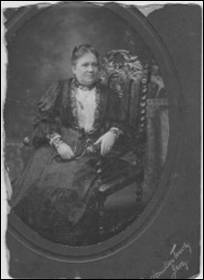
Figure 27. Kate Josephine Le
Mesurier.
(Photograph courtesy
Ancestry.com)
Colonel Andrew Alfred Le Mesurier, C.B. retired on the 20th of June 1888 and took up residence at St. Saviour, Jersey on the Channel Islands. At the time of his death on the 27th of April 1894 he was residing at 2 Diadem Villas, Parade Road, St. Helier, Jersey on the Channel Islands. He was buried on St. Saviour on the 1st of May 1894.
The Sons of Andrew Alfred Le Mesurier
Two of Colonel Andrew Alfred Le Mesurier’s sons served in the Army; Frederick Henry Stewart and Alfred Clive (see Annex No. 4).
Frederick Henry Stewart Le Mesurier
Frederick Henry Stewart Le Mesurier was born at Rhaniket, India on the 29th of April 1878 and his birth recorded at "New Infantry Barracks" Fulford Road, York Gate, Fulford, York, some two years later. He was probably sent to live with relatives in the Channel Islands for his education, as he was enrolled at Victoria College, Jersey, in 1890, at the age of 12. The 1891 Census of England shows him living with his parents in St. Saviour, Jersey.
He left the school in 1896 to enlist in the army, where he served in the ranks for 5 years 307 days, before being commissioned into The Border Regiment on the 2nd of August 1902. Frederick was promoted to Lieutenant on the 1st if April 1904.
Frederick married Edith Louis Le Brocq (1882-1982) at Jersey on the 19th of April 1906. Frederick and Edith had five children; Frederick D. (1907-1993), John Stuart (1910-1993), Clive (1915-1943), Richard (1915-1915) and Mary Shawford (1916-2004).
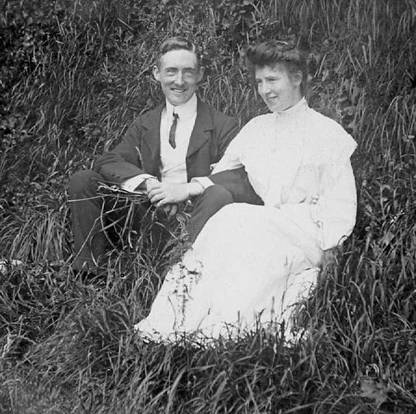
Figure 28. Frederick Henry Stewart and Edith Louise Le
Mesurier.
(Photograph courtesy of Ancestry.com)
Frederick’s regiment was posted to Gibraltar, then on to India, where they arrived on the 23rd of October 1908, moving on to Maymyo, Burma in October of 1912. Frederick was promoted Captain on the 7th of September 1914 while he was in Burma.
The regiment returned to England, landing at Avonmouth, on the 10th of January 1915. Le Mesurier first saw action during the Great War on the 25th of April 1915, when he landed with his regiment on “X” beach at Cape Helles, Gallipoli on the first day of the assault (87th Bde. 29th Division).56 The landing was only lightly opposed, although there was severe fighting to come.
Frederick left Gallipoli on the 12th of June with a head wound, and spent time recuperating on a hospital ship. He did not see active service next until he arrived in France with 1st Battalion of The Border Regiment on the 1st of February 1916, in time to take part in the Somme battles. He was made a temporary Major on secondment to The Durham Light Infantry on the 10th of March 1916. He departed France on the 2nd of August 1916 – again probably wounded (he was wounded three times during the Great War). He returned to The Border Regiment at the end of December 1916, retaining the rank of temporary Major, and was promoted to Major on the 18th of January 1917.
Le Mesurier was Mentioned in General Haig’s Despatches dated 4 January 1917 for services with the armies in France. He did not see further active service until he joined the Egyptian Expeditionary Force (E.E.F.) on the 18th of November 1917, being attached to the Egyptian Army on the 8th of December, and struck off the E.E.F. rolls on the 28th of December.
Major Le Mesurier was placed on half pay on account of ill health on the 8th of February 1921. It is possible that he was suffering from an illness contracted during his service in Egypt, or as the results of his three wounds. He returned to the Channel Islands as Deputy Assistant Adjutant General, Royal Guernsey (and Royal Alderney) Militia on the 20th of May 1921. He finally retired on the 20th of May 1925 at the age of 47. Presumably he left the Channel Islands shortly afterwards, as he was known to be living in Weymouth. Later he lived in Chipping Sodbury, Gloucester.57 Frederick died in Weymouth, Dorset in December of 1958 at the age of 80.
For his service Frederick Henry Stewart Le Mesurier was awarded the following medals:
1914-15 Star
British War Medal
Victory Medal with Mention in Despatches.
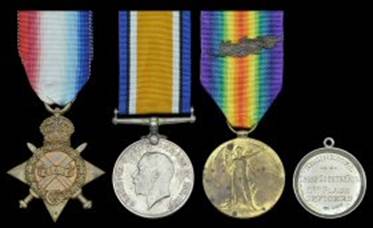
Figure 29. The Medals of Major Frederick Henry Stewart Le
Mesurier.
(Photograph courtesy of Dix Noonan Webb, 2015)
NOTE: The medal on the right without suspender or ribbon is a silver prize medal inscribed “Regimental Cross Country Run, 2nd Place Officers; 1st Border Regiment, May 1913.
It is of interest to note that the medals of Major F.H.S. Le Mesurier were sold by Dix Noonan Webb in a previous auction in 2011. At that time the medal group also contained the Khedive’s Sudan 1910-22 Medal, 1st issue, with clasp [NYIMA 1917-18] and named to El Bimbashi58 Le Mesurier, 4th Battalion, Egyptian Army with impressed naming. No explanation is given in the DNW catalog to explain why this medal was removed from the group in 2015. The 5-medal group sold for £1,900 in 2011 but only went for £900 in the 2015 auction, undoubtedly do to the loss of the Khedive’s Sudan medal. Perhaps it was discovered, by DNW or by the buyer of the group in 2011, that Le Mesurier did not receive the Khedive’s Sudan medal, or maybe the medal was lost or stolen sometime before 2015.

Figure 30. The Medals of Major Frederick Henry Stewart Le
Mesurier.
(Photograph courtesy of Dix Noonan Webb, 2011)
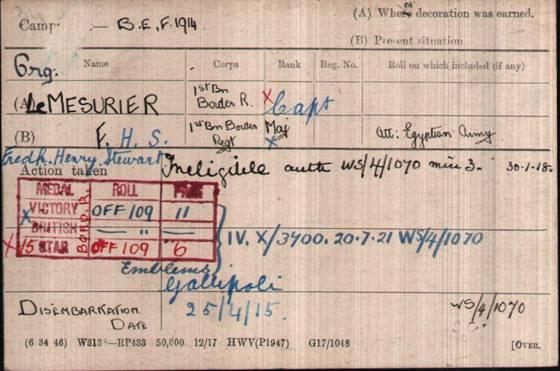
Figure 31. The Great War Medal Index Card of Major Frederick
Henry Stewart Le Mesurier (front side).
(Image courtesy of
Ancestry.com)
Alfred Clive Le Mesurier
Alfred Clive Le Mesurier was born on the 8th of September 1888. Clive was educated at Wellington College and at Victoria College in Jersey. He had been a member of the Cadet Corps and received his colours for both cricket and football. After leaving school he obtained an appointment on a tea plantation in India.
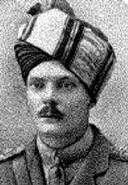
Figure 32. Lieutenant Alfred Clive Le Mesurier.
(Photograph
courtesy of The Channel Islands and the Great War)
When the Great War began Alfred obtained a commission in the 12th Indian Cavalry and later served in the 33rd Queen Victoria’s Own Light Cavalry. He was a member of the Indian Army Reserve of Officers. He was killed in action in Persia on the 29th of April 1915, age 26.
The following letter in the Jersey Evening Post of Saturday, 17 July 1915, describes the circumstances of his death, as it was published in the newspaper:
The late Lieutenant Le Mesurier. The following letter describing the circumstances in which Lieutenant A C Le Mesurier met his death has been written by a brother officer to one of Lieutenant Le Mesurier's relatives in Calcutta. Lieutenant Le Mesurier who was formerly a member of the Assam Valley Light Horse joined the Indian Army Reserve of Officers in November last. The letter reads: "My dear Mrs …. In going through your brother's papers I discovered that you were his next-of-kin in India and I am writing to tell you about the brave fellow's death and to condole with you in your bereavement. I used to know your brother at Wellington and we often used to talk over our school days together. I was not present in the action in which your brother met his death but I heard all the facts. As you know, perhaps, his Squadron Commander Major Anderson of my regiment was also killed at the same time. It happened like this - one Squadron of the 33rd and one of the 7th were sent out on reconnaissance some 25 miles from camp. They were met by Arabs who pretended to be friendly and warned them that the Turkish Army was only 3 hours march away and to go back. They went back about a mile and watered their horses and stayed there some time. When the Squadron had finished watering the Commander mounted the men and wheeling them about marched them off. A rear guard had been told off and your brother was sent to give them a message to keep much closer to the Squadrons. He galloped off, told the troop leader and started to come back, just as he turned hostile Arabs, who had been collecting around under the cloak of friendliness, opened fire. More mounted Arabs closed in and your brother was hit and fell off his horse. A native officer and three men were there but some were killed and surrounded by some 40 Arabs could not bring his body in and the remainder of the rear guard were cut up. In the meantime the remainder of the two Squadrons were being heavily infilladed [sic] and defiladed [sic] and were some 1000 yards away and so were unable to help. The next day a strong force of cavalry went out and recovered the bodies. Your brother was buried beside Major M H Anderson (33rd QPO Light Cavalry) and Lieutenant Bailward (26th KGO Light Cavalry) at Brackey some 30 miles from Ahway near the Karun River in Persia. I am sending all his personal belongings to you together with his bearer. I cannot say how sorry I feel over the death of your brother, my schoolmate, and I hope you will accept my condolences although they come from a perfect stranger".
Lieutenant A C Le Mesurier was an Old Victorian and was the fourth son of the late Colonel A A Le Mesurier formerly of St Saviour.
For his service in the war, Lieutenant Alfred Clive Le Mesurier was awarded the 1914-15 Star, British War Medal and Victory Medal. The latter two medals were issued to him by the government of India. He was entitled to the 1914-15 Star, although his Medal Index Card does not show that as being awarded.
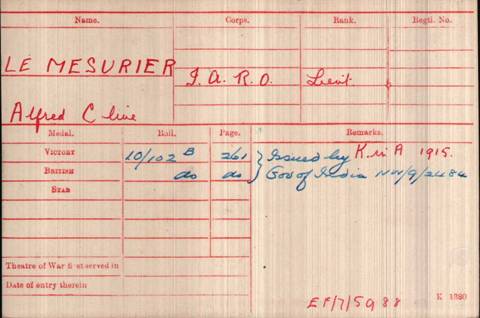
Figure 33. The Great War Medal Index Card of Lieutenant
Alfred Clive Le Mesurier.
(Image courtesy of Ancestry.com).
Clive’s brother, Frederick applied for his medals on the 26th of September 1921. At the time Frederick was living at 13 St. John’s Terrace in Weymouth. Frederick probably was also the recipient of Clive’s Memorial Plaque.
The Commonwealth War Graves Commission indicates that Clive is commemorated on the Tehran Memorial.
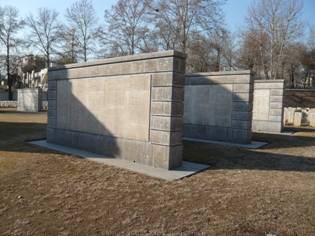
Figure 34. The Tehran Memorial.
(Photograph
courtesy of the Commonwealth War Graves Commission)
Andrew Charles Le Mesurier59
Andrew Charles Le Mesurier was a son of Colonel Andrew Alfred Le Mesurier. Andrew did not serve in the military. He was born in Jamalpore, India on the 3rd of September 1874. He married Clarice Evelyn Bridgnell (1892-1976) in St. Thomas’s Roman Catholic Church in Middleton Row, Calcutta on the 2nd of September 1911. Andrew and Clarice had children; Peveril Charles Kincaid (1912-1986), Joyce Ethel (1915-?), Denise Margaret (1918-1998) and Clive Arthur (1919-1978.
Clive Arthur Le Mesurier served in the military during World War 2 (see Annex No. 4). He served as an airman (No. 257789) in the Royal Australian Air Force from 1939-1948.
Clive was born on the 23rd of September 1919 in Kensington, London. He appears to have served in India, but the details of his service have not been uncovered during this research. He died on the 27th of October 1978 in Toronto, Canada.
12. EPILOGUE
Clive Arthur Le Mesurier’s story above concludes the tale of the 30 individuals, members of the family of Colonel Frederick Augustus Le Mesurier who was the principle character of this research. Again, 13 of these men served in the naval and military forces of the British Empire from the Victorian era through World War 2 and five of them died while serving. But the Le Mesurier story does not end with these individuals. The Commonwealth War Graves Commission lists a total of nine Le Mesuriers as casualties in the Great War (see Annex 5) and a total of five Le Mesuriers as casualties in World War 2 (see Annex 6).
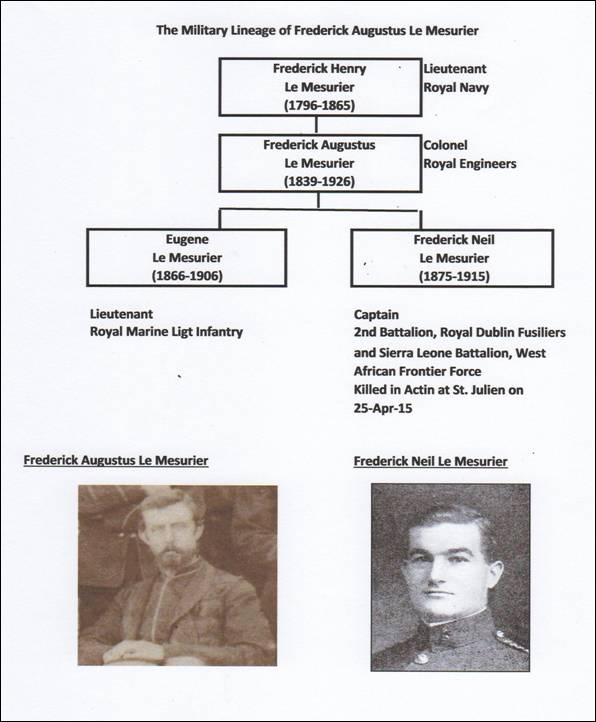
Figure 35.
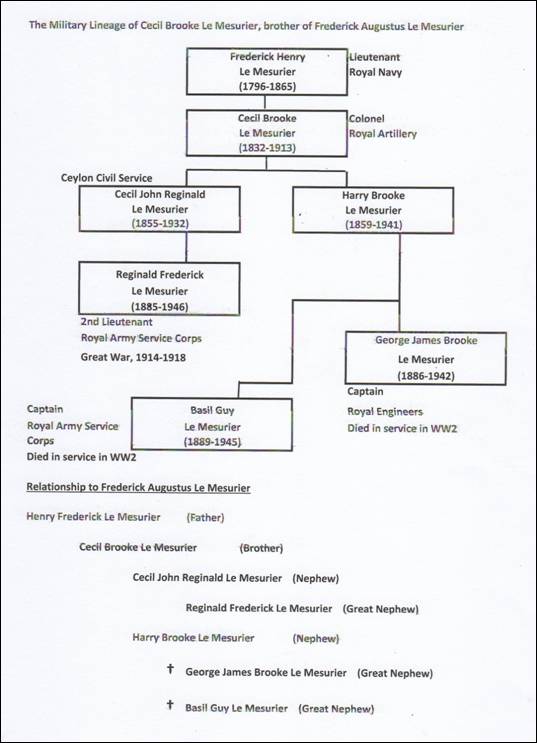
Figure 36.
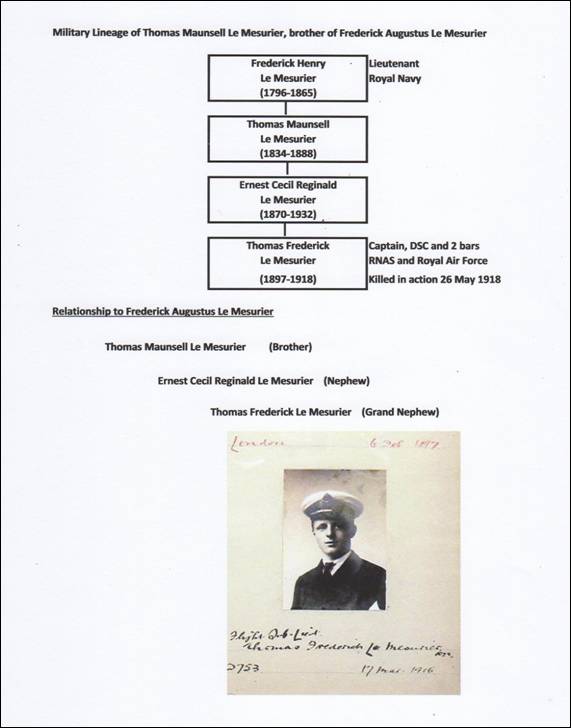
Figure 37.

Figure 38.
Le Mesurier Casualties in the Great War of 1914-1918
Name, Rank and Service Number |
Unit |
Date of Death |
Cemetery and Grave |
ALAN LE MESURIER Private Service Number: 7747 |
|
20 April 1918 |
LA NEUVILLE COMMUNAL CEMETERY, CORBIE
|
|
|
10 November 1917
|
|
|
|
|
|
|
|
|
|
|
|
|
|
|
|
|
|
ANDREW STUART LE MESURIER Private Service Number: 28995
|
16th Battalion Canadian Infantry |
19 May 1915
|
VIMY MEMORIAL France |
|
|
|
|
|
Indian Army Reserve of Officers
|
|
|
NOTE: The men in bold type were related to Colonel Frederick Augustus Le Mesurier and their lives and service are discussed in the narrative.
Le Mesurier Casualties in World War 2
Name, Rank and Service Number |
Unit |
Date of Death |
Cemetery and Grave |
|
|
|
|
|
|
|
|
|
|
|
|
|
|
|
RADIPOLE (ST. ANN) CHURCHYARD EXTENSION
|
GEORGES JAMES BROOKE LE MESURIER
|
|
|
|
ANNEX NO. 7

Figure
40. The Escape of Captains Haldane and Le Mesurier.
(Image
from mediastorehouse.com)
A captivating lithograph that transports us back to the tumultuous times of the Second Boer War in South Africa. Created by Henry Charles Seppings Wright, this print captures a thrilling adventure on the Komati River. In this dramatic scene, we witness two brave military captains, Haldane and Le Mesurier, making their daring escape from Pretoria. The tension is palpable as they navigate treacherous waters while being pursued by both human adversaries - the Boers - and unexpected animal allies - a group of baboons. The artist's meticulous attention to detail brings every element to life. The swirling river currents convey the urgency of their mission, while the dense foliage along its banks adds an air of mystery and danger. The expressions on Captain Haldane and Le Mesurier's faces reveal determination mixed with relief as they inch closer to freedom. This engraving originally appeared in The Illustrated London News in June 1900, capturing readers' imaginations with its thrilling narrative. Today, it continues to captivate viewers with its historical significance and artistic brilliance. "The Escape of Captains Haldane and Le Mesurier from Pretoria" serves as a reminder of humanity's resilience even in the face of adversity. It celebrates courage, resourcefulness, and unlikely alliances formed amidst chaos – qualities that transcend time and resonate with audiences across generations.
REFERENCES
Army Lists
Monthly Army List, April 1861, p. 58.
Monthly Army List, January 1868, p. 65.
Monthly Army List, July 1873, p. 179.
Hart’s Quarterly Army List, January 1876, p. 111.
Monthly Army List, March 1882, p. 192.
Monthly Army List, January 1884, p. 235.
Monthly Army List, April 1890, p. 18.
Monthly Army List, March 1898, p. 1112.
Monthly Army List, April 1900, p. 67.
Monthly Army List, June 1903, p. 1112.
Hart’s Annual Army List, 1906, p. 354.
Monthly Army List, April 1907, p. 62.
Hart’s Army List, 1908, pp. 287, 354, 938 and 1160.
Monthly Army List, December 1912, p. 314.
Monthly Army List, February 1915, p. 1546.
Books
Who War Who, 1916-1928.
The 26th Squadron RE. Published by the Squadron, 1988.
CARTER, T.F. A Narrative of the Boer War: Its Causes and Results. John MacQueen, London, 1900.
CONOLLY, T.W.J. Roll of Officers of the Corps of Royal Engineers From 1660 to 1898. The Royal Engineers Institute, Chatham, Kent, 1898.
DAVEY, A.M. The Siege of Pretoria, 1880-1881. M.A. Thesis, University of South Africa, 198_.
HAYWOOD, A. & CLARK, F.A.S. The History of the Royal West African Frontier Force. Gale & Polden Ltd., Aldershot, 1964.
PORTER, W. The History of the Corps of Royal Engineers. Volume II. The Institution of Royal Engineers, Chatham, Kent.
SANDES, E.W.C. The Royal Engineers in Egypt and the Sudan. The Institution of Royal Engineers, Chatham, Kent, 1937.
Census
1851 Census of England (HO 107/1851).
1871 Census of England (RG 10/906).
1901 Census of England (RG 13/1381).
1911 Census of England and Wales.
Correspondence
Letter from Nigel P. Wilson to the author, dated 6 February 1994, re: Le Mesurier Medals
Letter from Alan W. Rolfe to the author, dated 8 January 1998, re: The Will of Frederick Augustus Le Mesurier.
Documents
Certified Copy of an Entry of Death, General Register Office, Certificate No. DXZ 480627, dated 5 January 1998 (original dated 9 June 1926) for Frederick Augustus Le Mesurier.
Last Will and Testament of Frederick Augustus Le Mesurier, dated Oxford, 27 May 1918.
Medal Index Card, Captain Frederick Neil Le Mesurier, Royal Dublin Fusiliers.
Statement of the Services of Frederick Augustus Le Mesurier (WO 25/3913).
Register of Graves – Wolvercote Cemetery, Frederick Augustus Le Mesurier.
Royal Naval Officers Service Records Index, 1756-1931.
Royal Aero Club Aviator’s Certificate No. 2753 from the Central Flying School at Upavon, dated 17 March 1916, to Thomas Frederick Le Mesurier.
Graves Registration Report Form, Army Form W. 3372, re: Captain T.F. Le Mesurier, R.A.F.
Grave Registration Report Form, Army Form W. 3372 (Amended), re: Captain T.F. Le Mesurier, R.A.F.
Commonwealth War Graves Commission Commemoration, Thomas Frederick Le Mesurier.
Imperial War Graves Commission, Comprehensive Report (A) of Headstone Inscription for Thomas Frederick Le Mesurier.
Imperial War Graves Commission, Appendix 1.T. to Comprehensive Report A and B Headstone Inscription for Thomas Frederick Le Mesurier.
Imperial War Graves Commission, Headstone Personal Inscription for Thomas Frederick Le Mesurier.
Commonwealth War Graves Commission Index No. FR. 1359, Dunkerque Town Cemetery, p. 29, re: Captain Thomas Frederick Le Mesurier.
Statement of the Services of Thomas Maunsell Le Mesurier (WO 25/376).
Probate Calendar, 1888, p. 270 (Thomas Maunsell Le Mesurier).
War Diary, 33rd Queen Victoria’s Own Light Cavalry (WO95/5087-4).
Edinburgh Gazette
21 August 1855, p. 1027.
20 November 1857, p. 1106.
19 August 1864, p. 1054.
16 January 1866, p. 66.
2 August 1867, p. 886.
14 November 1899, p. 1065.
Family Trees
Ancestry.com. (Louisa Anne Browne).
https://www.ancestry.com/genealogy/records/louisa-anne-browne-24-55d04f
Ancentry.com. (Robert Candy).
Ancestry.com. (assemblyorder).
https://www.ancestry.com/family-tree/person/tree/9204285/person/25341365061/facts
Ancestry.com (Kel Payten).
Ancestry.com (VickyNewman69)
Ancestry.com (kirs10smith)
https://www.ancestry.com/family-tree/person/tree/21324435/person/190193478262/facts
Ancestry.com (johntyner)
https://www.ancestry.com/family-tree/person/tree/4489565/person/-1595662425/facts
Internet Web Sites
Grace’s Guide to British Industrial History.
https://www.gracesguide.co.uk/Frederick_Augustus_Le_Mesurier
Wikipedia: 1893 Birthday Honours.
https://en.wikipedia.org/wiki/1893_Birthday_Honours#Companion_of_the_Order_of_the_Bath_(CB)
Commonwealth War Graves Commission
Dix Noonan Web
https://www.dnw.co.uk/auction-archive/lot-archive/lot.php?lot_uid=165916
Ditsong: A Missing Heritage. Convent Redoubt.
https://ditsong.org.za/2020/09/22/a-missing-heritage-site/
Westerham Heritage.
https://www.westerhamheritage.org.uk/content/catalogue_item/rev-d-sydney-le-mesurier-2
Ireland’s World War I Casualties Memorial Records.
The Channel Islands and the Great War.
Corbitts Medals
https://www.corbitts.com/coin-auctions/auction34/single_campaign_medals-page1.html
HMS Fury (1814)
https://en.wikipedia.org/wiki/HMS_Fury_(1814)
The Aerodrome
http://www.theaerodrome.com/aces/england/le_mesurier.php
The Channel Islands and the Great War.
http://www.greatwarci.net/honour/guernsey/database/lemesurier-tf-dunkirk.htm
CASEMINE: Cecil John Reginald Le Mesurier v. Juliette Beatrice Armand Le Mesurier and Others (Ceylon).
https://www.casemine.com/judgement/in/5779f430e561096c9312fe54
India General Service Medal 1854.
https://en.wikipedia.org/wiki/India_General_Service_Medal_(1854)
The Third Anglo-Burmese War.
https://en.wikipedia.org/wiki/Third_Anglo-Burmese_War
London Gazettes
25 June 1850, p. 1783.
17 August 1855, p. 3129.
24 February 1852, p. 526.
10 February 1857, p. 472.
23 March 1858, p. 1533.
17 November 1857, p. 3856.
16 August 1864, p. 4028.
30 July 1867, p. 4225.
16 July 1872, pp. 3191 and 3192.
23 July 1875, p. 3717.
4 Sep 1877, p. 5098.
17 August 1880, p. 4509.
20 December 1881, p. 6762.
17 February 1882, p. 654.
18 April 1882, p. 1738.
9 June 1882, p. 2686.
10 July 1883, p. 3482.
23 Feb 1886, p. 851.
21 June 1887, pp. 3361 and 3362.
5 January 1888, p. 213.
3 Jul 1888, p. 3633.
3 June 1893, p. 3251.
10 November 1899, p. 6737.
15 March 1915, p. 2627.
15 October 1915, p. 10160.
28 February 1916, p. 2201.
9 May 1916, p. 4551.
1 January 1917, pp. 13 and 14.
12 May 1917, p. 4626.
29 June 1917, pp. 6413 and 6414.
29 August 1917, p. 8988.
14 September 1917, p. 9537.
21 June 1918, p. 7304.
Medal Rolls
Royal Engineers Medal Roll for Egypt 1882 with clasp [SUAKIN 1885] (WO 100/64).
West Africa Frontier Force Medal Roll, Africa General Service Medal [SIERRA LEONE] (WO 100/390)
Royal Dublin Fusiliers Medal Roll, Queen’s South Africa Medal (WO 100/209).
Royal Dublin Fusiliers Medal Roll, King’s South Africa Medal (WO 100/347).
The King’s Liverpool Regiment, IGS [BURMA 1885-7] (WO 100/69).
Periodicals
The London Times, 15 June 1926, p. 11d (Obituary).
The Royal Engineers Monthly List, January 1905, p. xviii.
Journal of Colonialism and Colonial History. Fragile Identities: The Colonial Consequences of CJR Le Mesurier in Ceylon.
School Registers
Oxford Men and Their Colleges, 1880-1892, p. 368.
ENDNOTES
1Who Was Who.
2Various family trees.
31851 Census of England.
4Who Was Who.
5Monthly Army List, April 1861, p. 58.
6Who Was Who.
7London Gazette, 30 July 1867.
8Connolly, T.W.J.
9The 26th Squadron RE, pp. 39 and 41.
10Who Was Who.
11Hart’s Quarterly Army List, January 1876, p. 111.
12Later Major, Officer Commanding 30th Field Company.
13Later Colonel Charles Ernest Commeline.
14DAVEY, A.M., p. 279.
15Ibid., p. 271.
16Ibid.
17Ibid., p. 283.
18Ibid., pp. 278-279.
19Ibid., p. 280.
20CARTER, T.F., p. 380.
21Ibid., p. 289.
22London Gazette, 17 February 1882.
23DAVEY, A.M.., p. 297.
24Ibid., p. 298.
25Ibid., p. 384.
26Ibid., p. 304.
27Monthly Army List, January 1884, p. 235.
28Later, Lieutenant General, C.B.
29SANDES, E.W.C., p. 70.
30Obituary.
31Who Was Who.
32These medals are in the author’s collection.
33The Register of Graves shows that Louis Anne Le Mesurier was buried at a depth of 9 feet, Frederick Augustus was buried at a depth of 7 feet and Lisa was buried at a depth of 5 feet. When the grave plot was purchased, it is obvious that it had been planned for three burials.
34Who Was Who.
35There is some contention among family tree researchers as to whether this actually is a photograph of Jane Catherine Le Mesurier.
36Royal Naval Officers Service Records Index, 1756-1931.
37Oxford Men and Their Colleges, 1880-1892, p. 368.
38Hart’s Annual Army List, 1906, p. 354.
39Dix Noonan Web and the Bond of Sacrifice, Volume II.
40Back of the Medal Index Card.
41London Gazette, 25 June 1850.
42London Gazette, 10 November 1899.
43One family tree gives his place of death as Windsor, Berkshire.
44Probate Calendar, 1888, p. 270.
45The Airco DH.4 was a British two-seat biplane day bomber of the First World War. It was designed by Geoffrey de Havilland (hence "DH") for Airco, and was the first British two-seat light day-bomber to have an effective defensive armament.
46The Aerodrome.
47The Airco DH.9 – also known after 1920 as the de Havilland DH.9 – was a British single-engine biplane bomber developed and deployed during the First World War. The DH.9 was a development of Airco's earlier successful DH.4, with which it shared many components.
48Family tree by assemblyorder and The Channel Island and the Great War.
49Supplement to the London Gazette, 29 August 1917, p. 8988.
50Family tree by assemblyorder and The Channel Island and the Great War.
51Supplement to the London Gazette, 21 June 1918, p. 7304.
52London Gazette, 17 August 1855 and the Edinburgh Gazette, 21 August 1855.
53London Gazette, 4 September 1877.
54London Gazette, 22 June 1880 and 18 April 1882.
55London Gazette, 9 June 1882.
56His cousin, Captain Frederick Neil Le Mesurier, Royal Dublin Fusiliers, was killed in action on this same day at St. Julien, near Ypres.
57Dix Noonan Webb Auction of 22 July 2015.
58Equivalent to the rank of Major.
59There is so question as to whether his name was Andrew Charkes or Charles Andrew (see BrianHayes88 family tree).